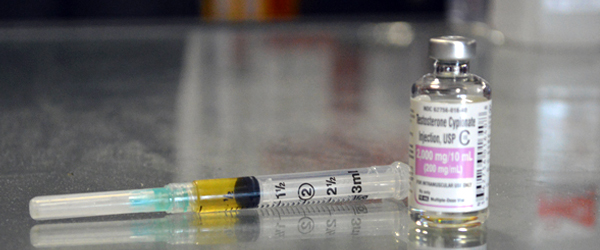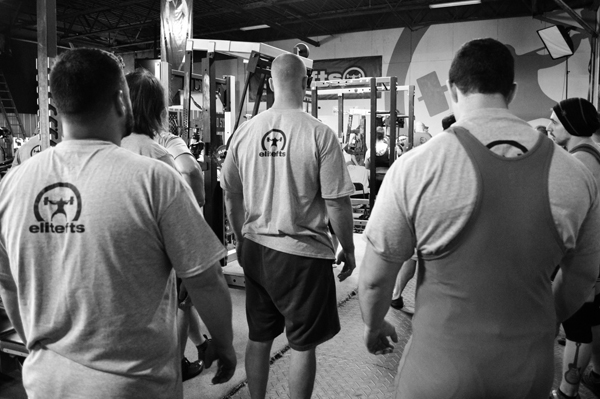
elitefts™ Sunday Edition
The purpose of this brief article is to expli andropause and its etiology (the cause of a disease or abnormal condition ) and to examine non-invasive treatment strategies that involve resistance exercise protocols.
Aging, or senescence, which is defined as the state of getting old, involves a host of complex physiological processes that are attributable to the accumulation of changes throughout the lifespan. The process of aging is influenced by lifestyle, heredity, and disease. Age is commonly associated with declines in physiological and neurocognitive functioning. Males are commonly aggrieved by a condition known as andropause, which is characterized by a reduction in serum testosterone levels and accompanying regressions in reproductive, urinary, metabolic, immune system, and emotional health.
Testosterone is a sex steroid hormone converted from dehydroepiandrosterone (DHEA) through the 17ß and 3ß-hydroxysteroid dehydrogenase enzymes, which permit further conversion to 5α-dihydrotesterone (DHT) by way of 5α-reductase activity so it may bind with androgen receptors, which allows it to immerse itself in a litany of physiological functions within the body on a cellular level. The production of male sex steroid hormones originate in the hypothalamus, whereby gonadotropin releasing hormone is secreted, prompting the discharge of luteinizing hormone (LH) from the pituitary gland, which in turn, stimulates testosterone production within the testicular Leydig cells. The pituitary gland also secretes follicle stimulating hormone (FSH), which stimulates the testicular Sertoli cells to produce sperm.
The decline in testosterone production over the lifespan is attributable to decrements in hypothalamic and testicular functioning. As a man ages, the volume of gonadotropin releasing hormone that is secreted decreases, thereby reducing the amount of luteinizing hormone production and ultimately diminishing the production of testosterone within the testicular Leydig cells. Less available testosterone plausibly explains collective reductions in libido, fertility, and metabolic and immunologic functioning.
Decreased libido can splinter a man’s confidence. Fertility issues can shatter relationships. Hampered metabolic functioning can lead to a concomitant decrease in lean body mass and an increase in fat mass. It should be noted that Vermeulen and colleagues showed a direct correlation between body composition and plasma testosterone levels (11). A disproportionate distribution of fat mass gives rise to conditions such as diabetes mellitus and coronary artery disease and invites conditions such as colds and viruses, which can be combated by leaner and stronger individuals, to stay longer and further depress the immune system. The downward spiral of sexual, metabolic, and immunologic complications can rob any man of his confidence and livelihood.
Luckily, scientific advances have made andropause a treatable condition (2). However, fears and financial costs surrounding pharmacological hormone replacement prevent those needing treatment from medicinal interventions. Literature has posed concerns with testosterone treatment, specifically aggravating preexisting prostate and cardiovascular conditions (7). While medicinal interventions are a vital component in combating andropause, resistance training should strongly be considered initially as a standalone or, at the very least, an adjunctive treatment due to the relatively low cost and non-invasive nature.
Resistance exercise has been shown in numerous research studies to elevate plasma steroid hormone levels (3, 8, 12). It appears that these acute hormone responses are critical to tissue growth, muscle strength, and hypertrophy. Ahtiainen and colleagues found significant correlations between training-induced elevations in testosterone and muscle cross-sectional area, which suggests that the acute elevation of testosterone in response to exercise may play a vital role in muscular hypertrophy (1). Therefore, these exercise-induced hormonal changes could potentially provide an important stimulus in older men and contribute to the age-related declines in strength, muscle mass, and functional abilities associated with andropause.
Multiple set resistance training protocols of moderate to high intensity using short rest intervals and stressing a large muscle mass may be optimal, as they appear to produce the greatest acute hormonal elevations (e.g., testosterone, growth hormone, and the catabolic hormone cortisol) compared with low volume, high intensity protocols using long rest intervals (6).
Ghigiarelli and colleagues noted that post-training salivary testosterone levels were higher among those following an established hypertrophic protocol involving three sets of ten repetitions performed at 75 percent of 1RM (4). Kraemer and colleagues found that a periodized resistance program enhanced adaptational ability to stimulate total testosterone after resistance exercise in older men (5). Additionally, Tremblay and colleagues reported greater exercise induced elevation in testosterone in resistance trained versus endurance trained men, which also suggests a chronic adaptive response (10).
Although the preponderance of research has examined the acute hormonal responses to resistance exercise, perhaps of most significance was a recent study by Sato and colleagues, which found that 12 weeks of resistance training significantly restored hormone levels in a group of 13 older men. Furthermore, steroidogenesis related enzymes, including 17ß and 3ß-hydroxysteroid dehydrogenase enzymes, mentioned earlier, were also significantly restored by resistance training. The researchers concluded that a progressive resistance training program could restore age related declines in sex steroidogenic enzyme and muscle steroid hormone levels in older men (9). These aforementioned studies all suggest chronic adaptations resulting from the incorporation of a progressive resistance training program.
Due to these acute and long-term adaptations, resistance exercise may serve as a viable intervention used to minimizing age related declines in strength and fat free mass associated with male andropause. The design and subsequent implementation of resistance exercise protocols will be influenced by a number of factors, predominantly including but not limited to neuromuscular and cardiorespiratory fitness, injury and medical history, anthropometry, and availability and accessibility of resistance training equipment, expertise and competency levels of exercise professionals prescribing and administering resistance exercise protocols.
References
- Ahtiainen JP, Pakarinen A, Alen M, Kraemer WJ, Hakkinen K (2003) Muscle hypertrophy, hormonal adaptations and strength development during strength training in strength-trained and untrained men. Eur J Appl Physiol 89:555–63.
- Brawer MK (2004) Testosterone replacement in men with andropause: An overview. Reviews in Urology 6:S9–15.
- Durand H, Castracane VD, Hollander DB, Tryniecki JL, Bamman MM, O’Neal S, Hebert EP, Kraemer RR (2003) Hormonal responses from concentric and eccentric muscle contractions. Med Sci Sports Exerc 35:937–43.
- Ghigiarelli JJ, Sell KM, Raddock JM, Taveras K (2013) Effects of strongman training on salivary testosterone levels in a sample of trained men. J Strength Cond Res 27:738–47.
- Kraemer WJ, Hakkinen K, Newton RU, et al (1999) Effects of heavy of strength development and steroid hormone responses to resistance training on hormonal response patterns in younger vs older men. J Appl Physiol 87:982–92.
- Kraemer WJ, Ratamess NA (2005) Hormonal Responses and Adaptations to Resistance. Exercise and Training Sports Med 35:339–61.
- Renneboog B (2012) Andropause and testosterone deficiency: How to treat in 2012. Rev Med Brux 33:443–49.
- Shaner AA, Vingren JL, Hatfield DL, Budnar RG, Jr Duplanty AA, Hill DW (2014) The acute hormonal response to free weight and machine weight resistance exercise. J Strength Cond Res 28:1032–1040.
- Sato K, Iemitsu M, Matsutani K, Kurihara T, Hamaoka T, Fujita S (2014) Resistance training restores muscle sex steroid hormone steroidogenesis in older men. FASEB J 28:1891–97.
- Tremblay MS, Copeland JL, Van Helder W (2003) Effect of training hormonal and growth factor responses to heavy resistance status and exercise mode on endogenous steroid hormones in exercise in men. J Appl Physiol 96:531–39.
- Vermeulen A, Goemaere S, Kaufman JM (1999) Testosterone, body composition, and aging. J Endocrinol Invest 22:S110–116.
- Willoughby DS, Taylor L (2004) Effects of sequential bouts of resistance exercise on androgen receptor expression. Med Sci Sports Exerc 36:1499–1506.









